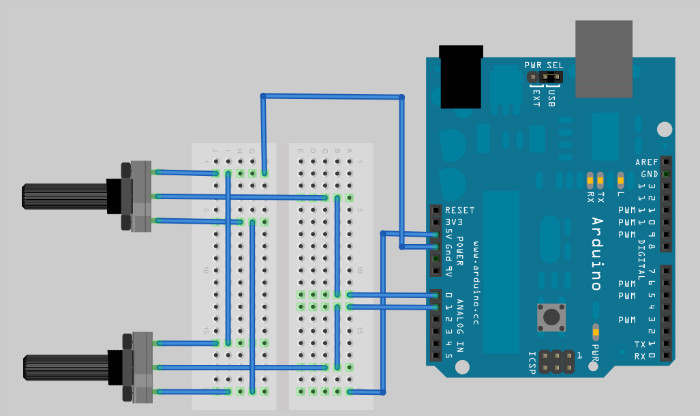Cloning Pong Part 2
This write up is part two of cloning pong, we will modify the pong game we created in part one, to be able to control it with knobs, like the original using Arduino.
To get Java communicate via Serial Port there are two options, JavaComm API and rxtx API. Arduino uses rxtx so I went with that. Navigate to you Arduino installation folder, for Mac OS X navigate into the Arduino.app,
open /Applications/Arduino.app/Contents/Resources/Java/
From the folder copy,
- RXTXcomm.jar
- librxtxSerial.jnilib
to somewhere on your classpath. Do not compile rxtx yourself, when I compiled it manually and put it on my classpath, Arduino IDE could not connect to the board, use the one supplied with your IDE, Mac OS X users make sure you are using 32 bit Java 1.5.0 otherwise you will get class not found exceptions.
Open Arduino IDE and make a note of your serial port name, on my machine its,
(def arduino-port "/dev/tty.usbserial-A6008nhh")
In order to open the serial port for I/O we need to get a port identifier from the API,
(defn port-identifier [] (let [ports (CommPortIdentifier/getPortIdentifiers)] (loop [port (.nextElement ports) name (.getName port)] (if (= name arduino-port) port (recur (.nextElement ports) (.getName port))))))
Using the identifier we can open the port for I/O, make sure baud rates match between Clojure and Arduino,
(defn open-port [] (doto (.open (port-identifier) "pong" 10000) (.setSerialPortParams 9600 SerialPort/DATABITS_8 SerialPort/STOPBITS_1 SerialPort/PARITY_NONE)))
Now everything is set to read from the port,
(defn poll-port [p] (with-open [in (BufferedReader. (InputStreamReader. (.getInputStream p)))] (.readLine in)))
Arduino will map knob reading between 0 and board size and will send coordinate pairs every 50 milliseconds, when poll-port is called, it will return,
"100:200"
meaning player one is at y 100 and player two is at y 200. We modify move-player function to check serial for input, parse the coordinates returned and set the player positions accordingly,
(defn move-player [coords player] (try (let [p1-y (BigInteger. (first (re-split #":" coords))) p1-x (:x (:1 @player)) p1-src (:src (:1 @player)) p2-y (BigInteger. (second (re-split #":" coords))) p2-x (:x (:2 @player)) p2-src (:src (:2 @player))] (dosync (alter player merge {:1 {:x p1-x :y p1-y :src p1-src } :2 {:x p2-x :y p2-y :src p2-src}})) ) (catch Exception e)))
Because we don't listen for key inputs anymore, we need to modify actionPerformed call and move players before every repaint,
(actionPerformed [e] (move-player (poll-port serial) player) (move-ball ball) (wall-collision ball player) (player-collision ball player) (.repaint this))
Thats all the modification needed in our pong game. Code for the Arduino is even simpler,
const int boardheight = 400; const int p1Potpin = 0; const int p2Potpin = 1; void setup(){ Serial.begin(9600); } void loop(){ int p1 = analogRead(p1Potpin); int p2 = analogRead(p2Potpin); Serial.print(map(p1,0,1024,0,400)); Serial.print(":"); Serial.println(map(p2,0,1024,0,400)); delay(50); }
We just read read the potentiometers every 50 milliseconds, map the reading between 0 and board height and write it to serial. Hardware setup looks like the following, fritzing project is also available check below for a list of files.
